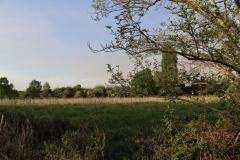
This month saw two momentous developments – the first use of poisonous gas on the Western Front and the landing of Allied troops on the Gallipoli Peninsular in Turkey.
Our single local casualty Private William Cole (1917) almost certainly witnessed the first event. As the Germans attacked the French on 22nd April at the start of the 2nd Battle of Ypres, they released chlorine gas from 5,730 cylinders. These formed poisonous green clouds that drifted towards Moroccan, Algerian and Senegalese divisions. Stunned and lacking any protection they, not surprisingly, retreated.
A four mile gap in the line appeared, but apprehension and lack of reserve troops meant that the enemy failed to capitalize on the opportunity. Despite heavy casualties the 10th, 13th and 16th battalions of the 18,000 strong Canadian Expeditionary Force plugged the gap. Urinating into cloths and putting them to their faces seemed to counter the effects of this terrible new weapon. One in three Canadians was a casualty. Gas attacks continued over the next few days at Gravenstafel and St Julien. The 1st, 2nd and 5th battalions of the Cheshires were involved.
William Cole was a member of the Territorial 5th who fought at St Julien. He died nearby on 29th April. Born in 1896 the 1911 Census found him living, aged 15 in South Oak Lane, Wilmslow with his widowed mother Ellen, three sisters and three brothers. He was a farm servant. His mother, a Shropshire woman and his two elder sisters Lillie and Minnie ran a laundry from their home.
As a "terrier" he joined the Earl of Chester's battalion in August 1914 and moved with them to Shrewsbury, Church Stretton, Northampton and then Cambridge before landing at Le Havre in February 1915. He is buried at Spoilbank Cemetery (sometimes called Chester Farm) 4.5 km from Ypres and is commemorated on Wilmslow War Memorial and in St Bartholomew's Church.
By the end of the battle on 25th May the salient had been compressed and Ypres reduced to rubble – but the line held. Casualties were huge – 59,000 British, 18,000 French, 6,000 Canadians and 35,000 Germans. The numbers almost certainly explained by the use of gas.
The second campaign that caused many deaths began on 25th April when 70,000 Allied soldiers comprising British, French, Australians and New Zealanders (15,000 "Anzacs" in all) landed in the Dardanelles at Cape Helles, Sedd-el-Bahr and Anzac Cove. The reinforced Turks were well prepared, supplied and trained by the Germans. Amid sweltering and disease-ridden conditions the awful, ineffectual stalemate dragged on until January 1916 when we were forced to evacuate our troops.
As the months of 1915 wore on many local boys were to suffer terribly fighting the Ottoman Empire here.
Guest post by Jon Armstrong and Alan Cooper
Wilmslow Historical Society









